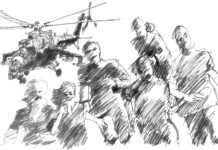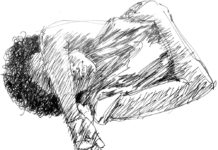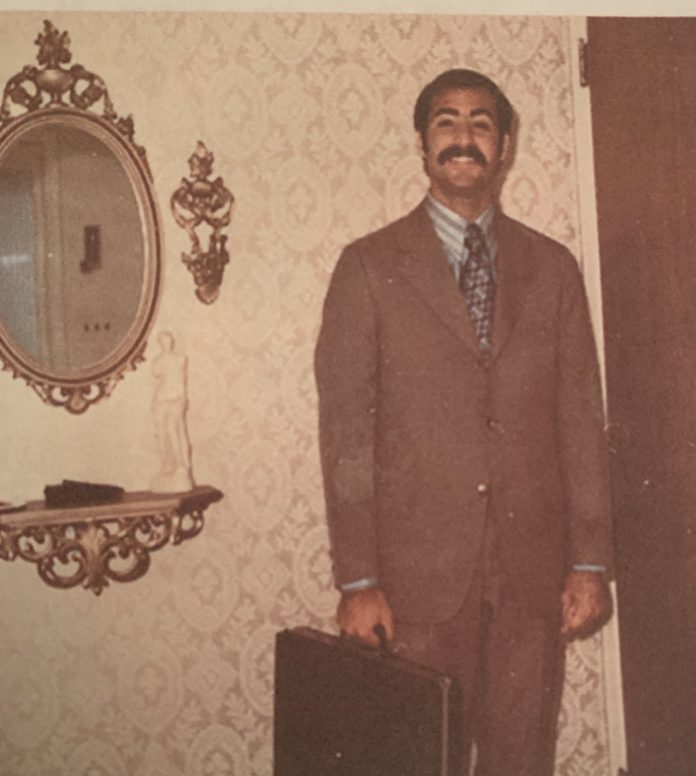Leaving my parents’ home in New Jersey for my first day of work. (Moustaches were big in ’73!)
Pub. Note: Last week, Jim Copacino and Betti Fujikado concluded the sale of Copacino+Fujikado to a trio of new owners—Managing Director Scott Foreman, Executive Creative Director Mike Hayward and Director of Engagement Strategy Tim O’Mara.
Betti and he will continue to work on special projects and serve as advisors, at least through 2020. The transition of ownership has been a carefully planned, three-year process, to ensure a smooth handover of responsibilities.
Betti and Jim founded the agency on Jan. 1, 1998, to begin what Jim called “a thrilling 22-year run,” adding, “I fully expect the talented team at C+F to build on our modest success and to do great things going forward.”
Below is the message that Jim shared with the staff on one of his last days as a co-owner. The headline reflects Jim’s ever-present wit: Thoughts On The Down Elevator…
In a few weeks, the sale of our agency will be complete, and Betti and I will be handing over the reins to our talented trio of new owners. As I tiptoe toward the exit, I’d like to share a few thoughts with you about the long road that’s led to this moment—and my hopes for the agency going forward. (Note: If you manage to read all of this, there’s a little “extra” at the end.)
I landed my first real job in marketing communications in 1973 at a tiny sales-promotion agency on Madison Avenue called Alan Wolsky & Friends. Early lesson: when someone has to broadcast that he has “friends,” it should be a tipoff.
Wolsky was an acerbic, fast-talking, cigar-chomping character from Brooklyn who wore white suits—even in the dead of Winter. Our receptionist was a burly ex-Teamster named Sam, who carried a concealed weapon. (Did I mention that Alan owed money to a lot of people?)
One of our clients, Kleinert’s, was a family owned company in the garment district that manufactured, among other things, dress shields: fabric inserts designed to be pinned or sewn into garment underarms to prevent perspiration stains. Honest, I’m not making this up:

A few months after being hired, I came up with an idea for the brand’s annual consumer ad. When presented to the notoriously difficult Mr. Kleinert (another cigar-chomper), he actually applauded. As we descended in the elevator after the presentation, Alan reached into his pocket and handed me a crumpled $20 bill. “You did good, kid,” he said. “Go out for a nice dinner tonight.” My first bonus.
It wasn’t a glamorous beginning to a career. But it was a $13,500-a-year writing job for an English major with no experience or apparent skills. I quickly fell in love with this quirky craft of ours: the challenging thrill of combining words and images, based on a business strategy, to inform, entertain and persuade. All in the fleeting seconds of a page turn, a roadside billboard or a TV commercial.
The ensuing years led to a number of stops on the advertising highway: DDB and Y&R in New York— then Chiat/Day (later spun off as Livingston & Co.), Cole & Weber, and McCann-Erickson in Seattle. All culminating in a 22-year run at Copacino+Fujikado, with my inimitable co-founder.
There have been highs: account wins, Cannes Lions, One Show Pencils, Ad Age Northwest Small Agency of the Year (twice), multiple Big M and ADDY Awards and long relationships with great people and brands at Alaska Airlines, the Seattle Mariners, Seattle Children’s, Premera and others. There also have also been lows: account losses, failed new-business pitches, underperforming campaigns and the death of our beloved colleague and first employee, Steve Cunetta.
But even in the tough times, the ride was always worth the price of the ticket.
In the past decade, our industry has encountered head-spinning changes at warp speed. Digital technology has unleashed new media formats, new disciplines and new tools that make us smarter and faster—enabling precision targeting and instant, accurate measurement.
But the ability to count an impression doesn’t mean that we’ve made an impression.
In its highest form, the art of persuasion is an act of shared imagination between seller and buyer. As we rely more on machine learning and big data, I hope we can fully leverage the potential of technology to create human, emotional stories that make people laugh, cry and dream.
Robots and goose bumps.






